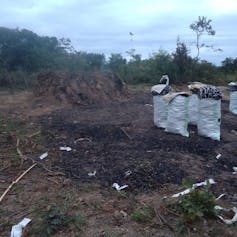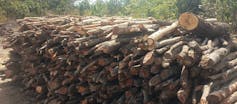COP30: Zambia’s forest communities need finance for solar power – so they don’t have to cu
November 16, 2025
Across rural Zambia, small solar home systems and lanterns have transformed daily
life. Between 2018 and 2022, more than one million small solar devices were sold across the country. These range from tiny solar lanterns to home kits capable of powering radios, TVs and phone chargers.
Children can now study after dark, phones stay charged, and families no longer rely entirely on smoky kerosene lamps.
However, these solar systems are neither funded nor subsidised by the government or development finance institutions. And affordable credit for rural people to buy clean energy is rare. Buying small solar systems has created new financial pressures on households to pay for long term instalment plans.
Read more:
Solar power in Zambia: ‘If it works for my neighbour, I’ll try it too’
I’m pursuing a PhD in renewable energy adoption and management in rural areas and was part of a team of researchers in sustainable energy, environmental studies and rural green transitions. We looked at how rural Zambian forest communities pay for solar power and how their payment methods affect long-term use of the forest.
We interviewed 80 people and conducted 10 focus group discussions over 28 months in Zambia’s Mkushi, Kapiri, Mposhi, Chongwe and Luano regions. These areas are home to around 700,000 people combined. But they have minimal access to the national electricity grid. Most households rely on firewood and charcoal for energy.

Courtesy Hillary Chanda
Our research found that people are paying for solar power by cutting down trees and over-harvesting forest products.
Once dense Miombo woodlands, rich with mopane worms, mutondo (wild mango) and other fruit trees, these forests now stand thinned and patchy. The people we interviewed described the forest loss, and our own geospatial analysis of forest cover loss from 2001 to 2023 in the same areas confirmed this.
Read more:
Discovering the forest wonders of Africa — and the threats they face
Deforestation has always existed in Zambia’s rural areas, but our study shows it is being intensified by the rapid promotion and adoption of solar technology, and the need to generate a regular income to cover the monthly payments.

Supplied
The decline in trees is not only ecological but social. As trees disappear, firewood collection becomes more difficult, wild foods grow scarcer, and rural communities lose an important buffer against climate shocks.
This calls for affordable, innovative and inclusive financing models that don’t force households to exploit forests to cover the monthly payments.
Solar loans are driving forest loss
Over 85% of participants reported funding their solar purchases with income from selling charcoal, timber, honey, and other forest products sourced from what they viewed as nature’s bank – the forest.
One charcoal burner told us:
Times are hard, and there is so much demand for charcoal with fewer right trees.
Hence, we have been forced to start cutting even useful trees like fruit trees and medicinal trees.
Another said:
Though we produce charcoal, we rarely use it for cooking as it’s meant for sale. All of us here depend on firewood … Charcoal is for the wealthy … (laughs).
Read more:
Cameroon’s Baka people say they are part of the forest: that’s why they look after it
Another person we interviewed collects wild honey from the forest to sell. They told us:
… a 2.5 litre (of honey) sells for US$15 (K300), and natural honey is always in high demand … it sustained me and helped me buy a good bicycle, household items and even pay back the solar lighting loan.
In Mkushi, a woman who collects and sells mopane worms, a seasonal delicacy, said:
I sell the worms at US$25 (K500) per 20 litre container. In a good season you can raise a lot of money … I did not struggle to buy uniforms for my children, necessities, a nice phone, radio and the solar lighting.
However, those who had previously used the forest sustainably reported that they now had to engage in harmful practices to afford the monthly instalments. For example, honey harvesters described cutting branches that supported beehives, whereas previously they would carefully smoke out the bees and collect honey without damaging the trees.
Others mentioned bark stripping for rope-making, digging up medicinal roots, and
clearing woodland to expand small farms as soil fertility declines.
The paradox of clean energy and forest finance
Solar technology itself is not to blame. The problem lies in how it is financed. People typically make a small down payment of 10%-15% of the cost to take the system home, and then pay the system off over a one- to three-year period. If they miss one monthly payment, the solar systems lock and cannot be used.
For communities living near forests, the only way to earn enough for regular solar payments is to sell forest resources, using more from the forest than previously.
Read more:
Why rural electrification won’t fix deforestation in Zimbabwe

Courtesy Hillary Chanda
The problem lies in huge policy gaps – energy programmes focus on expanding solar access but rarely consider how households pay for the systems. Forest conservation efforts don’t cater for rural energy needs. Solar vendors push for market growth, conservation agencies promote tree planting, and communities remain stuck in between, adopting clean energy while financing it in environmentally damaging ways.
In many areas, traditional leaders or local officials who should regulate forest use are themselves selling charcoal. This blurs accountability and makes community-led conservation efforts difficult to sustain.
Inequality is also to blame. Wealthier households and commercial farmers can afford to buy solar systems outright. Poorer families, especially in forest-adjacent areas, often have no choice but to extract value from their surroundings. These choices are not made out of ignorance, but necessity.
What needs to happen next
Inclusive financing that offers affordable, flexible payment options such as loans, subsidies, or pay-as-you-go models adjusted to rural income cycles are needed.
As the global climate change summit, COP30 approaches, the world’s leaders should prioritise green energy for forest-adjacent communities that have never had access to the national grid.
Read more:
Nigeria needs to close the financial inclusion gap for women smallholder farmers
COP30 should commit to targeted solar subsidies, micro-credit and community energy schemes so that rural people across Africa who buy solar systems don’t have to rely on forest income to pay for these. COP30 can also boost research funding to understand and address the links between rural energy access and deforestation. With such support, these communities could finally access clean power without costing their forests.
Zambia’s energy and environment ministries must also urgently co-ordinate their work so that solar expansion in rural areas does not happen at the expense of forests.
Read more:
Forest conservation approaches must recognise the rights of local people
Deforestation in rural Zambia has multiple causes, and solar adoption is just one. But it’s significant because it reflects a structural gap in development planning.
Solar remains one of the most promising tools for addressing energy poverty in sub-Saharan Africa. But sustainability must be evaluated not only by the cleanliness of the technology, but also by the ways in which it is acquired and maintained.
Search
RECENT PRESS RELEASES
Related Post


